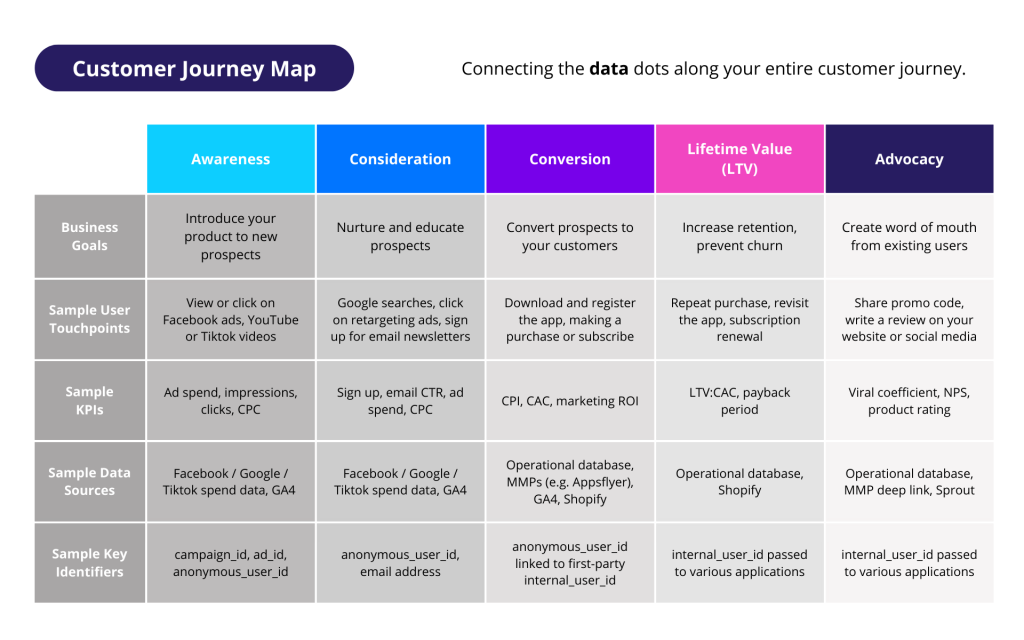Customer Journey Data Map
All (data) strategies start from the customer journey.
How do consumers come to know about your products and services? What level of nurturing or product education is required to help prospective customers make a decision hence convert to registered or paying users? Once a customer, how to make sure they keep coming back and using the product? With a growing base of loyal customers, how to encourage them to advocate for your product and bring in more new customers hence creating a healthy, high-impact, low-cost growth loop?
As a marketer, your goal is to get more people into this funnel and encourage as many of them through the entire journey, not just to first click or first purchase. You want more users and more from each user.
It is important to understand the big picture before zooming into specific parts (e.g. landing page conversions or onboarding flows) so you know exactly where the opportunities and pressure points are. These are the areas to apply efforts and dig deeper.
On a high level, focus on the key user touchpoints and moving them along the journey. We categorised the customer journey into five stages: awareness, consideration, conversion, lifetime value (LTV) and advocacy. Each stage has different goals, user touch points and data considerations associated with it, as described in the chart below.

Data Along The Customer Journey
Core KPIs
Here are the two sides of the coin: how much you spend on acquiring a user (CAC) and how much return you gain from a user acquired (LTV). Together, you can evaluate campaign performances and marketing ROI.
Customer Acquisition Cost (CAC)
It is important to define the action that qualifies as a customer acquisition. For example, it could be a download or completed registration or first purchase or subscription uptake. You can map out additional metrics throughout the conversion funnel: impressions, clicks, downloads, registrations, first purchases etc.
On the spend side, centralise marketing costs across all channels both online and offline. Your Blended CAC = Total Marketing Cost / Number of Customers Acquired. We will dive into more granular marketing performances (e.g. campaign, adset, ad or keyword level) later.
Customer Lifetime Value (LTV)
Once a customer converts, they start paying back the acquisition cost throughout their lifetime usage of your products or services. Depending on the type and stage of your business, you may choose to evaluate lifetime value in terms of revenue, profit, and / or the network effect a user generates (in case of a freemium app).
Data Touchpoints
Pre-Conversion
Before a user converts, they are anonymous to you, aka you cannot uniquely identify them beyond the anonymous ids provided by tracking solutions, e.g. user_pseudo_id from GA4. You have data visibility everytime they interact with your application. For example, landing on your website, viewing various product pages or signing up for content. It is important to structure your UTM parameters across all channels to ensure consistent tracking. The anonymous id is used to link all events to a user pre-conversion.
If you are acquiring users to a mobile app, pre-conversion journey can be captured via a Mobile Measurement Partner (MMP), e.g. AppsFlyer or Adjust.
There are certain tracking limitations relating to cookies and the iOS14 changes, which can be catered for with probabilistic modelling. We will cover this topic in more detail in the future.
Post-Conversion
Once a user converts, they are identifiable via your internal user id and you should have visibility and the ability to connect all touchpoints, e.g. purchases, subscriptions and email engagements etc. The key is to ensure the internal user id is passed to all systems providing and capturing the user activity, e.g. your CRM or sales systems.
Growth Loop
In addition to keeping your existing customers happy, some of them can be powerful advocates for your products. Encourage them to submit reviews, share promo codes and share the words about you. From a data perspective, ensure each flow captures and passes the internal user id so you can perform detailed analysis on virality.
Connecting The Data Dots
We discussed using an anonymous user id to connect all user touch points prior to them becoming a customer then internal user id afterwards. At the point of conversion, trigger an event that captures both ids so you can merge all user touchpoints and attribute them to a single customer. From here, the analytics and data science power is unlimited!
We hope this article provides a high level overview of how data is captured throughout the customer journey.


